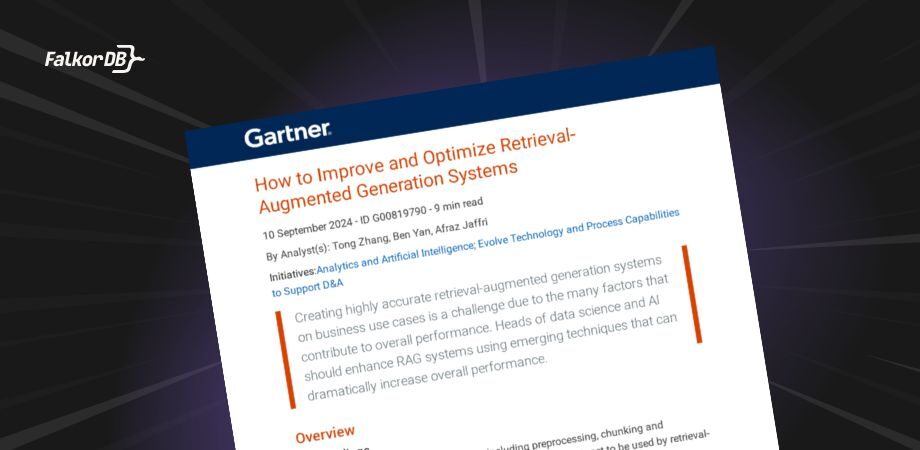Retrieval Augmented Generation (RAG) systems have gained significant traction in the AI community. Gartner’s recent findings and recommendations shed light on critical challenges and opportunities in this domain.
Industry Context and Pain Points
RAG systems aim to enhance AI outputs by grounding them in reliable, up-to-date information. However, enterprises face hurdles in implementing effective RAG solutions:
- Data Quality: Organizations struggle with fragmented, outdated, or inconsistent data across various systems.
- Retrieval Accuracy: Simple vector-based retrieval often falls short in complex scenarios.
- Response Relevance: Generated responses may miss crucial information or include irrelevant details.
- System Performance: Poorly defined objectives lead to frequent rework and suboptimal results.
Gartner’s Key Findings
Gartner’s analysis reveals four critical areas impacting RAG system effectiveness:
- Data Preparation: Inadequate preprocessing, chunking, and embedding strategies compromise dataset quality.
- Retrieval Methods: Over-reliance on vector-based retrieval limits knowledge recall quality.
- Information Summarization: Failure to condense retrieved information and leverage prompt engineering leads to poor-quality responses.
- Question Understanding: Lack of diligence in defining query requirements results in system rework and performance issues.
Vector RAG vs Graph RAG: Key Differences
There are several methods to do RAG, with Vector RAG and Graph RAG representing two distinct approaches to enhancing Large Language Models (LLMs) with external knowledge. Each method has unique strengths and limitations, particularly when addressing Gartner’s key findings on RAG systems.
Data Representation
Vector RAG represents information as numerical vectors in high-dimensional space. This approach excels at finding thematically relevant information, making it suitable for tasks like document search or product recommendations.
Graph RAG, conversely, uses knowledge graphs to map entities and their relationships. This structured approach provides a deeper understanding of context and connections within the information.
Retrieval Mechanism
Vector RAG employs similarity searches in vector space to find relevant information. While efficient for large datasets, this method may struggle with complex, multi-step reasoning tasks.
Graph RAG traverses the knowledge graph, identifying entities and relationships relevant to the query. This allows for more sophisticated reasoning and inference based on the graph’s structure.
Context Preservation
Vector RAG often chunks data into smaller pieces for embedding, which can lead to loss of context and relationships. This limitation can impact the quality of retrieved information for complex queries.
Graph RAG maintains the structural integrity of information, preserving relationships between entities. This approach provides richer context for the LLM to work with.
While Vector RAG offers efficient similarity-based retrieval, Graph RAG's structured approach addresses several of Gartner's concerns more effectively.
FalkorDB Tweet
Recommendations and Implementation Strategies
To address these challenges, Gartner offers five key recommendations:
Comprehensive Data Preparation Pipeline
Implement diverse chunking and embedding techniques to optimize internal knowledge organization. This approach enhances retrieval effectiveness.
Example: A financial services firm could segment customer data into meaningful chunks based on transaction history, risk profiles, and product preferences. Embedding these chunks using domain-specific models would improve retrieval accuracy for customer-related queries.
Highlight: Vector RAG’s chunking process can result in fragmented information. Graph RAG better preserves data relationships, potentially improving dataset quality.
Hybrid Retrieval System
Combine lexical, vector, and graph search with reranking models to improve retrieval accuracy and relevance.
Example: An e-commerce platform could use keyword search for product names, vector search for semantic similarity, and graph search to explore product relationships. Reranking results based on user behavior would further refine relevance.
Highlight: Vector RAG relies primarily on vector-based retrieval. Graph RAG inherently combines multiple retrieval methods by leveraging graph structures, which are particularly useful in the context of Gartner’s recommendation for hybrid retrieval systems.
Summarization Techniques
Apply methods to condense retrieved information, providing more focused input for the language model.
Example: A legal firm could summarize lengthy case documents, extracting key facts, dates, and rulings. This condensed information would serve as a more effective basis for generating case-specific advice.
Highlight: Vector RAG may struggle to provide comprehensive summaries due to its focus on similarity. Graph RAG’s ability to traverse related concepts could offer more contextually rich summaries.
Prompt Engineering
Optimize answer quality through careful prompt design.
Example: A technical support system could use prompts that include specific product details, common issues, and resolution steps. This structured approach would guide the model to generate more accurate and helpful responses.
Query Transformation
Expand question context and clarify ambiguities to improve information retrieval from multiple sources.
Example: A healthcare system could transform a simple query like “What are the side effects?” into a more specific form: “What are the potential side effects of [specific medication] for a patient with [relevant medical history]?”
While Vector RAG offers efficient similarity-based retrieval, Graph RAG’s structured approach addresses several of Gartner’s concerns more effectively.
Using GraphRAG-SDK
- Data Preparation: Use GraphRAG-SDK to create efficient graph representations of complex data relationships, enhancing the quality of embeddings.
- Hybrid Retrieval: Integrate graphrag-sdk’s graph-based search capabilities with vector and lexical search methods for a more comprehensive retrieval approach.
- Query Transformation: Employ graphrag-sdk to expand queries by traversing related nodes in the knowledge graph, providing richer context for information retrieval.
Conclusion
Implementing Gartner’s recommendations can significantly enhance RAG system performance. By focusing on data preparation, diverse retrieval methods, information summarization, prompt engineering, and query transformation, organizations can overcome common RAG challenges.
Integrating tools like graphrag-sdk can further optimize these processes, particularly in areas requiring complex data relationship modeling and graph-based search. As RAG systems evolve, adopting these strategies will be crucial for organizations seeking to leverage AI for more accurate, context-aware, and valuable insights.
